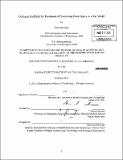Collagen scaffolds for treatment of penetrating brain injury in a rat model
Author(s)
Elias, Paul Z. (Paul Ziad)
DownloadFull printable version (22.95Mb)
Other Contributors
Harvard University--MIT Division of Health Sciences and Technology.
Advisor
Myron Spector.
Terms of use
Metadata
Show full item recordAbstract
Recovery from central nervous system (CNS) injuries is hindered by a lack of spontaneous regeneration. In injuries such as stroke and traumatic brain injury, loss of viable tissue can lead to cavitation as necrotic debris is cleared. Using a rat model of penetrating brain injury, this thesis investigated the use of collagen biomaterials to fill a cavitary brain defect and deliver therapeutic agents. Characterization of the untreated injury revealed lesion volume expansion of 29% between weeks 1 and 5 post-injury. The cavity occupied parts of the striatum and cortex in the left hemisphere, and was surrounded by glial scarring. Implantation of a collagen scaffold one week after injury resulted in a modest cellular infiltrate four weeks later consisting of macrophages, astrocytes, and endothelial cells. The scaffold was able to fill the cavity and provide a substrate for cellular migration into the defect. Incorporation of a Nogo receptor molecule aimed at binding inhibitory myelin proteins did not appear to promote axonal regeneration, but resulted in increased infiltration of macrophages and endothelial cells. The increased vascularization observed within the scaffolds represents a modified environment that might be more suitable for regenerative therapies. A scaffold was also used to investigate the delivery of neural progenitor cells one week after injury. After four weeks, viable implanted cells were found to have differentiated into astrocytes, oligodendrocytes, endothelial cells, neurons, and possibly macrophages/microglia. These results demonstrate the potential utility of combinatorial therapies involving collagen biomaterials, myelin protein antagonists, and neural progenitors for treatment of CNS injuries.
Description
Thesis (Ph. D.)--Harvard-MIT Division of Health Sciences and Technology, 2011. Cataloged from PDF version of thesis. Includes bibliographical references (p. 192-204).
Date issued
2011Department
Harvard University--MIT Division of Health Sciences and TechnologyPublisher
Massachusetts Institute of Technology
Keywords
Harvard University--MIT Division of Health Sciences and Technology.